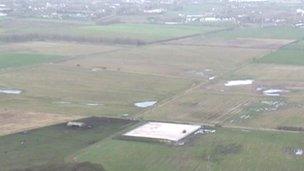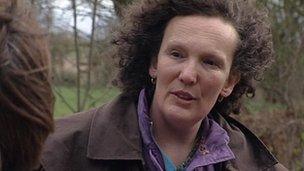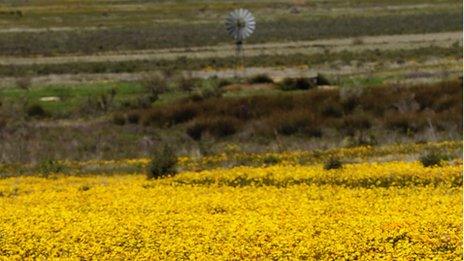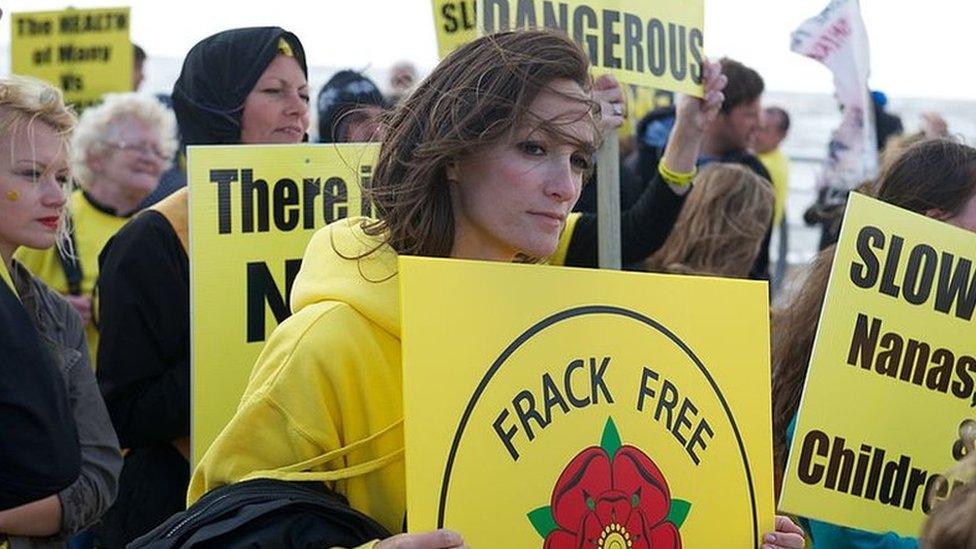Fracking: Concerns over gas extraction regulations
- Published
Concerns over fracking gas extraction regulations
Last year, Blackpool and other parts of Lancashire's Fylde coast were rocked by two earthquakes. The tremors were only small, and geologists will tell you quakes of this size happen quite naturally about 10 times a month.
But the tremors have placed the coastal resort at the epicentre of a new controversy because what stood out about these earthquakes is that they were not natural phenomena.
They were caused as engineers tried to extract shale gas - methane - from beneath the Earth's surface, using a technique called fracking.
Fracking, or hydraulic fracturing to give it its proper name, is a way to extract natural methane gas trapped inside layers of densely-packed shale rock a mile or so underground.
Engineers drill down, line the well with metal and cement casings, and then use controlled explosions to open up fractures in the rock.
They then pump down millions of gallons of water at high pressure, along with sand and chemicals, to prop open the fractures so the gas can escape.
Fracking was controversial before the earthquakes. After them, drilling was called to a halt while a UK government review took place.
Any day now, review complete, the government is expected to give the go-ahead once more, most likely with some additional safety measures tacked on.
But Newsnight has discovered worrying signs that regulation is not keeping pace with the industry.
Untapped billions
Lancashire could prove a test case for a much larger operation. According to the British Geological Survey (BGS), there are shale deposits stretching under the Pennine Basin from Blackpool to Scarborough, in the Midland Valley in Scotland and even possibly in the Weald and Wessex basins of southern England.
Cuadrilla Resources, currently the main player in shale gas in the UK, estimates there are some 200tn cubic feet of shale gas beneath the Lancashire hills alone - worth many billions of pounds.
But experience of fracking in the US suggests it might be possible to extract only about 10% of that. The BGS calculates some 4.5tn cubic feet might be extractable, though it concedes that Cuadrilla has real-world data from its exploratory well sites that the BGS lacks.
Closest to the truth is that no one really knows how much gas is there, or how much can be extracted, until extensive drilling begins.
We spoke to Mike Hill, a technical advisor to Lancashire's Fylde Borough Council, and a former oil and gas man.
He is not against fracking, saying that he thinks it is a good idea to make the most we can of this potential new source of energy, but he wants to ensure it is done properly.
Mr Hill's concern over the earthquakes is not that they might damage housing, but the effect they could have on cement that holds the casings in place in the bore hole.
If this cracks or fractures, he says, there is a serious risk that methane gas, or fracking fluids, might escape.
He wants the state of the wells checked, but is anxious that the Health and Safety Executive (HSE), responsible for worker safety and well integrity, has too few staff and resources to regulate this new industry.
Checks system
Mr Hill says he feels they are relying too heavily on paper checks, rather than truly independent, physical testing:
"When I asked them: 'OK, how many times have you come down? How many times have you inspected?', they said: 'Cuadrilla say they're doing X, Y and Z.'
"'How many times have you actually checked they are doing X, Y and Z?' And the answer? 'None.'
"Not once in two years has the HSE visited any of the wells in Lancashire to test, inspect or verify for themselves."

Potential fracking sites, such as the white square seen here, are often near population areas
The HSE told Newsnight it did visit two of Cuadrilla's drill sites last year, and had five face-to-face meetings with Cuadrilla to discuss well engineering and operations.
They denied being content to rely on reassurances from Cuadrilla itself, adding that the company had to submit well designs before they could be constructed, and a weekly report during well operations, including hydraulic fracturing.
The HSE also said that if the government gave consent for Cuadrilla to continue hydraulic fracturing, it planned "a joint HSE and EA [Energy Agency] inspection at which one of the topics for attention will be the safe management and monitoring of sub-surface activity".
Anti-fracking groups here in the UK, and local residents, have concerns over fracking. They have seen online videos from America of flaming water taps, reports of gas leaks and a lack of transparency about chemicals used by companies over there.
Contaminated water threat
A Newsnight investigation in 2010 found some in the industry denying that fracking could result in gas leaks.
But America's second largest natural gas company, Chesapeake Energy, admitted it had found evidence of gas leaks and had changed its procedures. We found regulators trying to catch up and impose rules after serious problems had already occurred.
In Lancashire, we spoke to Christine Dickinson, who runs a caravan park close to one of the proposed drilling sites.

Christine Dickinson runs a caravan park close to one of the proposed drilling sites
"We don't want it here on our doorstep where it could contaminate the water for the birds and could contaminate our spring water - I've got a spring here and we don't want to take that risk," she said.
I put it to her that this is a tremendous energy resource that cannot be ignored.
"For the short term it will make very few people a lot of money… but I don't think overall it's going to benefit us," she responded.
Mike Hill took us to the Preese Hall site near Blackpool - the only one in the UK so far that has been partially "fracked".
Left over fracking fluid is still being stored here. It has picked up natural radiation from underground, so is radioactive itself, at only a low level, but above that allowed by the Environment Agency.
"When you frack a well you put about two million gallons of water down it. About one million flows away with the fracking chemicals into the formations, and we don't know where it goes.
"Then about one million gallons will come back up the well. They'll recycle it so they'll be left with about half a million gallons per well, and if they have got 842 wells then probably about 400 million gallons of water that needs to be disposed of - ranging between 10 and 90 times the permissible radioactive limit," Mr Hill said.
Drop in gas prices
We asked the Environment Agency what plans were in place to deal with the flowback fluid stored at Preese Hall, and how it intended to regulate this aspect of fracking in the future as potential volumes increased.
The agency said Cuadrilla would need to apply for a permit to dispose of the 80 cubic metres of flowback water, and conceded that things might yet need to change:
"We consider that we have the regulatory framework to protect the environment during exploratory shale gas projects - but this would have to be reviewed if ever there was a move to full-scale operational mode."
Mr Hill is calling for a new set of regulations to encompass every aspect of the fracking process, and associated risks. He told Newsnight that those currently in place are best suited to the offshore oil and gas industry, and could not simply be transferred onshore.
Newsnight wanted to interview Cuadrilla, where former BP head Lord Browne is a director, to ask the company about its practices, regulation and local concerns, but we were turned down.
In response to questions, it did say: "Cuadrilla believes that the tough and comprehensive regulatory regime that is now in place will ensure that the UK can benefit from shale gas safely and securely." It also said it had an ongoing dialogue with local residents.
The company said it believed "the huge potential for shale gas [in the UK] represents a significant opportunity for Cuadrilla… which would include a significant number of new jobs in Lancashire and across the UK, that could have a transformative effect on the local and national economy".
If the industry rides out local opposition in Lancashire and finds it really can extract as much as it hopes, and safely, then the impact of shale gas in the UK could be dramatic.
It has already brought down gas prices in the US, and this poses a dilemma for the government.
Turning to gas for a few more years pushes visions of a carbon-free energy supply further into the future. But it could help to solve fuel poverty and boost the economy.
As it ponders this potential new source of home-grown energy, that promise may prove too tempting to resist.
- Published20 March 2012

